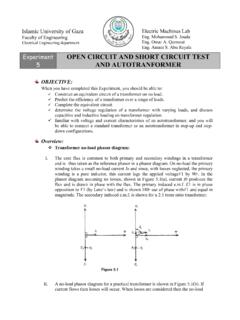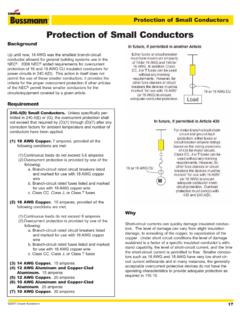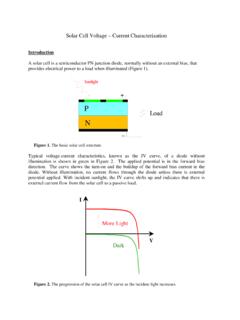Transcription of Open Circuit Voltage and Short Circuit Current - Windy Nation
1 Open Circuit Voltage and Short Circuit CurrentPublished on ( )Open Circuit Voltage and Short Circuit Current Numerous kinds of alternators and generators are often sold which might not be appropriate at all for use in a windgenerator. Most often, the real power capabilities of an alternator are obscured by wild claims about open circuitvoltage (OCV) and the Short Circuit Current (SCC). Stop being fooled! This article will describe what open circuitvoltage and Short Circuit Current , and explain why they are important for designing a wind turbine that producesoptimal power in real world wind 3-phase generator produces wild Alternating Current (AC) that is converted to Direct Current (DC) by a3-phase bridge rectifier as shown in the diagram below.
2 The resulting rectified DC Voltage can be used to charge abattery, feed a grid tie inverter (GTI), or can be used with a DC heating element to heat air or water. In most cases,small wind generators are used to charge one or more batteries which are commonly referred to as a battery 1: A flow diagram of a wind turbine generator charging a 12 volt are two fundamental characteristics of a generator that need to be known to determine if it will be a goodcandidate as part of a wind turbine. The first is Open Circuit Voltage and the second is Short Circuit Circuit Voltage for Wind TurbinesGenerators spinning with no load (nothing attached to the rectifier) generate an Open Circuit Voltage (OCV).
3 Thisvoltage is proportional to the RPM of the generator and is fairly linear, meaning there are a fixed number of RPM sper volt. As the rpm of the generator increases, the Voltage example, if the OCV of a generator is 12 VDC at 100 rpm, then at 200 rpm the OCV of the generator will beroughly 24 VDC. This suggests that when you double the RPMs, you are doubling the designing a wind turbine, it is important to match the RPM performance of the generator to the RPM 2010 Windy Nation Inc. All Rights Reserved | Legal |About UsTestimonialsPrivacy PolicyOur PrinciplesJob OpeningsContact UsBulk OrdersNewsletterQuestionsRMA RequestShoppingReturn PolicyShipping FAQC ommunityWind Turbine BladesGeneratorsGrid Tie 1 of 4 Open Circuit Voltage and Short Circuit CurrentPublished on ( )performance of the rotor blade set covering the normal 8 30 MPH wind speed an example, let s design a good OCV for a wind generator that is going to be used to charge a 12 volt batterybank.
4 You want the OCV of the generator to produce about 12 VDC in about 7-8 mph winds in order for the windturbine to start charging the 12 volt battery , many generators or DC motors that look good at first glance require much higher RPM to reach 12 VDC than what a good set of wind turbine blades will develop. As an example, let s assume you are using 35-inchblades (like our WindGrabber [1] Blade Series) and hit 250 RPM in a 7-8 mph wind. If the 35 inch blades can do250 rpm in 7-8 mph winds, then we know that our generator must produce an OCV of 12 VDC at about 250 rpm.
5 Ifwe design the generator to produce 12 VDC at about 250 rpm and use the 35 inch blades, then we will have a windturbine that produces the correct OCV to properly charge a 12 volt battery bank!As a side note, usually small ~1000 Watt wind turbines operate in the 200 800 RPM range. Yes, it is possible toadd gearing, but just like a geared bicycle, the blades become harder to turn, and higher wind speeds are requiredto get them spinning and to keep them spinning. There is no free lunch. It is generally better to select a generatorthat can generate 12 VDC at a fairly low RPM and not to use you read on, here is a video which shows the open Circuit Voltage vs.
6 RPM of our Windtura 750 generator:And before we start talking about Short Circuit Current , watch this video of the Short Circuit Current vs. RPM for ourWindtura 750 generator: Short Circuit Current Applied to Wind TurbinesSo let s say we found or designed a generator that can produce an OCV of 12 VDC at the correct RPM s for ourblade set. The next question is, Can it produce sufficient Current (amps) as RPM increases? This is where ShortCircuit Current (SCC) comes in. In this case, the DC Positive and the DC Negative outputs of the bridge rectifierare tied together (shorted), and an ammeter is used to measure the Current as the RPM increases.
7 A test of up to800 RPM on a powerful motor stand is sufficient in most cases to determine what the SCC curve of a generator like in the Voltage case, there are some generators that simply do not produce much Current at 800 RPM to beconsidered good candidates for use in a small ~1000 Watt wind turbine. (If you forgot why we are using the number800 rpm, it is because that is about the maximum rpm that a small 1000 Watt wind turbine is going to hit in highwinds. We don t care about the SCC of a generator at 5000 rpm because a wind turbine will never reach an rpmthat high)It is important to note that the MAXIMUM Current a generator can develop is when it is Short circuited.
8 Once abattery or some other load is added, there is more resistance in the Circuit , and thus there will be less Current thatcan flow. In practice, the most Current you will ever see from a generator in a real world application is about 50-70%of the SCC in a well designed is the OCV and SSC for the Current Windtura 750 (2012). Some improvements may happen in the future sodon t consider this chart to be anything other than a snapshot of the Current state of our PMA. The gas driven teststand in the two videos above was used to generate this data.
9 2010 Windy Nation Inc. All Rights Reserved | Legal |About UsTestimonialsPrivacy PolicyOur PrinciplesJob OpeningsContact UsBulk OrdersNewsletterQuestionsRMA RequestShoppingReturn PolicyShipping FAQC ommunityWind Turbine BladesGeneratorsGrid Tie 2 of 4 Open Circuit Voltage and Short Circuit CurrentPublished on ( )Figure 2: OCV vs. RPM and SSC vs. RPM for the Windtura 750 GeneratorYou can see that the OCV reached 12V at about 140 RPM and rose at a constant rate relative to RPM(approximately RPM/volt or about volt/rpm). The SCC was about 18 amps at 140 RPM and peaked above50 amps at the higher RPMs.
10 This is exactly what a good candidate generator for a small wind turbine looks like:The OCV of the Windtura 750 approximately doubles when the rpm of the generator doubles. And the SCCcontinues to quickly increase in the 200-800 rpm range!In practice, when matched with a set of our WindGrabber blades, the Windtura 750 Generator can produce 35-40amps in high winds (27-30 mph). On a 12V battery system, this translates to about 500 watts delivered to thebattery bank, and on a 24V system over 1000 watts is : Don t Get Tricked by Dishonest SellersCAUTION One trick used by some suppliers is to advertise fantastic levels of watts by taking the OCV andmultiplying it by the SCC!











